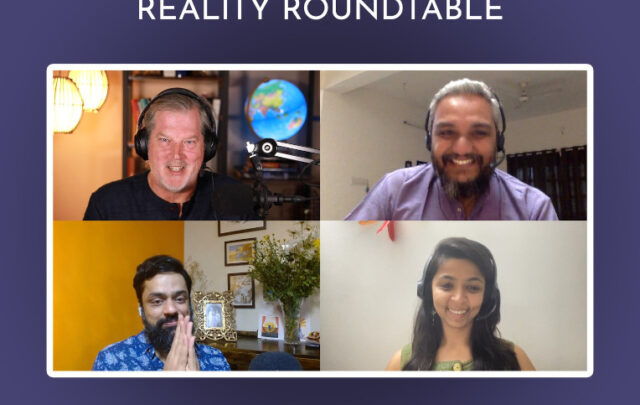Faced with accelerating disruptions and social and environmental breakdowns, traditional forms of philanthropic giving may be less effective than they once were. Confronted with societal divisions, wars, and the climate crisis, core actors in philanthropy have begun to ask how philanthropy can respond more effectively in moments of a polycrisis. How can philanthropy deal with new forms of hypercomplexity? What is the role of philanthropy in responding to breakdown, and how can it promote regeneration and transformation?
Numerous experiments and innovations in the philanthropic sector are responding in various ways to these disruptive challenges — from trust-based funding to participatory grant-making to flexible multi-year core grants for transformative infrastructure building.
Underlying these innovative efforts is a desire to create systemic and long-lasting impact that leads to a transformation of existing patterns, and that supports sustainable and inclusive change for the well-being of communities and the planet.
Three Types of Complexity
In our work at the Presencing Institute we believe that most solutions to the challenges we face already exist. But what is missing is our collective capacity to implement these solutions in a timely way and at scale. We also believe that the role of philanthropy is shifting. Traditional forms of charity and donor-defined problem-solving can provide effective solutions to straightforward challenges, but the new complexities of the polycrisis require new approaches from all sectors. There are implications for (a) the relationship between philanthropy and social change makers and for (b) the awareness and mindsets that guide philanthropic activity.
The discipline of systems thinking can help us to understand complexity. Three types of complexity play into the challenges that our institutions and communities face (see Figure 1).

Figure 1: Three types of complexity: dynamic, social, emerging (Source: Scharmer, C. O. (2019), Theory U, p. 58).
Dynamic complexity concerns delayed feedback loops: cause and effect are distant in space and time. For example, carbon emissions from past decades in distant places have an impact on the climate across the globe. Dealing with this type of complexity involves the use of whole systems methodologies (e.g., system dynamics).
Social complexity concerns differences in views and interests: a variety of stakeholders bring different interests and worldviews to a situation. One recent example was the attempt by the COP 28 stakeholders to agree on a joint statement. Dealing with social complexity successfully requires using refined multi-stakeholder methodologies to bring together diverse interests and viewpoints in collaborative problem solving.
Emerging complexity is the defining feature of the pressing challenges facing our planet, our institutions, and our communities: disruptive challenges whose solution is unknown, in part because the problems keep changing and evolving. Examples of this kind of complexity range include technology (AI), health (Covid 19), war, terrorism, structural violence (e.g., in the Middle East), and climate-related disruptions. Dealing with emerging complexity requires a systems view rather than a silo view. For example, the Paris Agreement only a few years after the collapse of the climate talks in Copenhagen showcased how an awareness- and systems-based approach to leadership can shift the thinking of the respective stakeholders from an egosystem view to an ecosystem view. Doing this new leadership work effectively requires methods and tools for transformative systems change.
Four Types of Philanthropy
In summary, philanthropy today faces, like everything else, increasing levels of complexity. The following matrix outlines four types of philanthropic activity that each respond to systemic complexity differently. In reality, concrete examples of philanthropic giving may blend elements of more than one of these types. But to clarify the different types (and their underlying logic), it may be helpful to look at the table below.

Table 1: Four Types of Philanthropy
Philanthropy — literally, love for humanity — has traditionally taken the form of charitable and individual giving (Philanthropy 1.0). The challenge is defined, and the donor helps. A community needs a library, a school needs a gym, or individuals need food and shelter. A recipient might acknowledge a gift by naming a space after a large donor or publishing the names of smaller donors. These gifts meet an immediate need but usually do not eliminate the root causes of the problem. Root causes may include poverty, inequality, exclusion from opportunity, systemic racism, and climate destabilization to name a few. Addressing the systemic issues that led to the problems requires a different type of response.
Philanthropy 2.0 introduces measurable outputs and outcomes and aims to increase the efficiency and impact of the giving. A foundation might develop a strategic focus (such as reducing CO2 emissions, reducing class size, or improving access to health care) and an indicator system that measures the impact of giving in those areas.
The recent popularity of effective philanthropy has demonstrated that working with quantifiable indicators has efficiency advantages, but it also assumes that the philanthropist knows what the problem is and how to best address it. Critics of this approach have pointed out strong power imbalances as well as a bias to funding impact areas that are more easily measurable in the short term, and that it reduces the accountability of philanthropic decision makers. For example, US philanthropy gives out $500 billion a year and European philanthropy gives about $60 billion a year. What is society’s return on the tax advantages that the wealth holders receive on that $560 billion? Is that investment moving us toward a better world by addressing the root causes of society’s problems, or is it (and the trillions of dollars in financial assets that generated them) just perpetuating them?
The hallmark of effective philanthropy is the categorical separation between how you make your money (often by hyper-extractive practices that harm planet and people) and how you spend it (on donor defined symptomatic problem-solving), but it tends to turn a blind eye to the deeper systemic root issues and thus amplifies inequality and ecosystem breakdowns.
Philanthropy 3.0 is more collaborative, experimental, and long-term, and it includes the perspective of the grantee to a larger degree. For example, the community-based foundation Maine Initiatives is an innovator in this sort of participatory grant making. Local communities not only define the focus areas of their giving but also decide who will receive grants. In 3.0 philanthropy the relationship between the philanthropy and the change maker is collaborative. Dialogue is central to its success, and giving is embedded in specific social contexts. Funder collaboratives, donor-advised funds, and impact investment are other types of experiments with 3.0 philanthropy that include some emerging features of 4.0 giving.
Philanthropy 4.0 is an emerging form of philanthropic activity that focuses on transformative systems change. 4.0 philanthropy aims to address the root causes of a challenge by taking a whole-system perspective. The guiding goal of 4.0 philanthropy is to seek transformations that generate flourishing and prosperity for all. These sorts of transformations — e.g,. reducing structural violence, institutional racism, or environmental destruction — require the constructive input from the entire system in devising solutions. Measuring progress and success in these areas is difficult, and these sorts of systemic root issues often require long-term interventions. The characteristics of philanthropy 4.0 include trust-based relationships, larger multi-year grants, and capacity building with the participation of the entire ecosystem of partners. These same characteristics without the intention or goal of systems evolution or transformation would not constitute 4.0 philanthropy.
Several organizations have taken first steps toward 4.0 giving. For example, the Lankelly Chase Foundation’s CEO Julian Corner has said: “We got stuck and realized we are part of the problem.” So it created a “transition pathway” for dismantling itself and moving its assets into communities who can use these assets in any manner that they see fit.
Another is the V. Kann Rasmussen Foundation. In 2020 the board of the foundation reflected on its role in light of the planetary emergency, and concluded, “we have to do much more to meet this existential threat within the rapidly dwindling time left to address it.” The board decided to “spend down its endowment over the course of the next fifteen years, allowing us to double our annual grantmaking during these crucial years.”
The Dutch Postcode Lottery provides unrestricted institutional core funding to NGOs to support key civil society organizations and helps them to strengthen their ecosystem of collaboration. The Ford Foundation’s BUILD program (Building Institutions and Networks) is a $1 billion initiative that also aims to strengthen the capacity of civil society organizations through unrestricted long-term funding. These examples matter in the current context where civil society organizations in most countries have been under attack.
The Eileen Fisher Foundation works to move the apparel industry toward “regenerative fashion design”; the company Eileen Fisher Inc. innovates in that same space.
Another example of transitioning to 4.0 was recently explored and researched by The Bridgespan Group, which identified the funding of Field Catalysts as a key leverage point for fighting inequality. Field catalysts are people and initiatives that are not primarily concerned about the growth of their own organizations but want to do and provide whatever would help move their entire ecosystem of partners and stakeholders toward equity.
A different kind of philanthropic intervention, supported by the Presencing Institute, helped bring improvements to a maternal health project in Namibia. The intervention encompassed a microcosm of the local health system: from governmental health officials to nurses. Working closely with mothers and local groups, the healthcare system was able to establish new institutional structures that were more responsive to the needs of mothers and their children. These large changes were possible because the grantmakers that supported the project accepted the “not-knowing-all-the-answers” approach and the involvement of partners from all levels of the system.
Other initiatives focus on building cross-sector transformative leadership infrastructures, including the Presencing Institute’s u-lab and IDEAS program. u-lab is a free online, multi-local capacity-building platform supporting systems change; it has taken more than 240,000 registered users from 186 countries on an innovation journey over the past nine years. IDEAS, in collaboration with a foundation partner in Southeast Asia, United in Diversity, supports infrastructures that take leaders from business, government, civil society, and academia on a joint action learning journey of understanding the root problems in their system and addressing them with prototyping cross-sector solutions.
It is noteworthy that the most important systemic impacts of these philanthropic efforts only become visible years (in some cases decades) later. This is in stark contrast to the traditional two-year grant cycle common in philanthropy 2.0.
Philanthropy 4.0 not only changes the relationship between philanthropy and grantees from transactional to transformative; it also incorporates a new form of shared awareness and intention that allows all partners in the system to adapt and co-evolve as needed by a changing environment. Philanthropy 4.0 investments are guided by long-term systemic objectives.
Complex Problems Require Complex Solutions
Which type of philanthropy is best? It depends. For known problems with known solutions at a moderate level of complexity, a 1.0 or 2.0 way of operating works because it is efficient. But in contexts that are defined by disruption and/or by emerging complexity — that is, in environments with evolving problems and evolving solutions — a different approach is called for. More sophisticated 3.0 and 4.0 philanthropy reflect this new context of societal change. Complex challenges require complex solutions. Addressing them with 2.0 giving would be, as a colleague from the United Nations put it recently, like trying to “get to the moon using a donkey cart.”
Philanthropy 3.0 and 4.0 differ from 2.0 by giving the grantee freedom to respond flexibly in the face of fast-changing environments and disruption. We were fortunate to have that freedom in March 2020, when Covid hit and much of the world moved into lockdown. It took us at the Presencing Institute only a few days to mobilize a core team to provide a critical sense-making space for our community. Over the course of a few months, roughly 15,000 people participated regularly in bi-weekly online gatherings, using deep listening, stillness, and awareness-based social practices to make sense of the disruption and to reimagine and reshape their own journeys forward. That intervention, called the GAIA Journey (Global Activation of Intention and Action), has led to numerous place-based initiatives that continue to generate change across the planet. Our fluid improvised actions were entirely made possible by a trust-based grant that let us put together a program that we believed would serve the community’s needs.
Shifting the Locus of Philanthropic Action Upstream
Stepping up philanthropic activity at the 4.0 level requires shifting the impact focus of philanthropy from downstream (short-term metrics) to upstream (evolving and transforming mindsets and operating systems).
These evolutions require an inquiry into the root causes of the challenges we face. An amazing number of change makers worldwide are pursuing these inquiries. But they often must operate in isolation and frequently lack the methods and tools to approach transformative change more consciously and more collectively.
What we’ve learned over the years is that the success of a transformational process in a system is a function of two things: one, a shift in mindset of the people who are enacting these systems; and two, a supporting infrastructure that helps these change makers to navigate that journey. These supporting infrastructures have been the enabling condition for movements around the world (from the decolonization movement in India, the anti-apartheid movement in South Africa, to the civil rights movements in the United States in the 1960s and in Eastern and Central Europe in the 1980s, etc.). Behavioral and transformational change needs an intentional support structure. Civil society and cross-sector initiatives often lack these high-quality support structures.
The current polycrisis and wave of systemic breakdowns cannot be solved by the same thinking that created them. Philanthropy 4.0 tackles systemic challenges at their root by shifting the locus of intervention from downstream (outcome-driven) to upstream (operating with new mindsets and operating systems) including:
- Scalable institutional infrastructures that bring together all relevant players to co-shape the evolution of the system.
- Co-creative leadership capacities for shifting awareness from a silo to a systems view — i.e., from ego to eco.
- Methods, tools, and spaces that support new collaborative and co-creative capacities.
All of these components exist, at least in the form of seeds and prototypes. What’s missing is the supportive environment — the soil, the nutrients, the water, the light — that allows these seeds and prototypes to grow, to connect, and to become operational collectively. Shifting the primary locus of change in philanthropic action from merely downstream to also upstream could provide a much-needed boost to transformative change initiatives that help to realign intention with action at the level of the whole system.
I thank Saskia van den Dool-Gietman, John Heller, Antoinette Klatzky, Emma Paine, and Katrin Kaufer for their feedback and valuable input, as well as a network of interviewees who volunteered their time.





